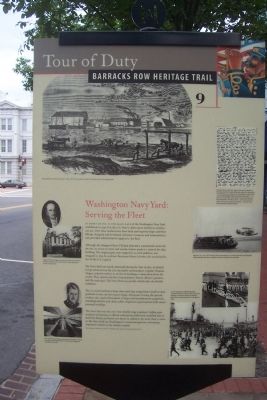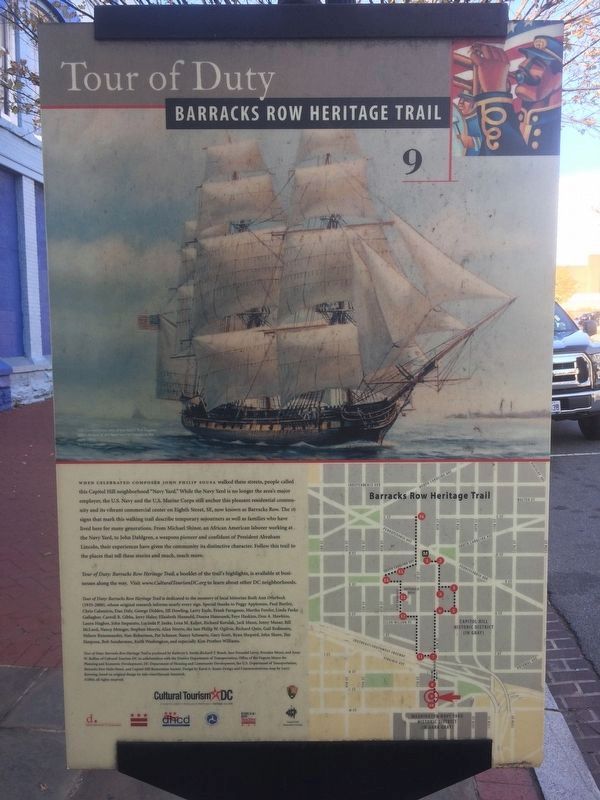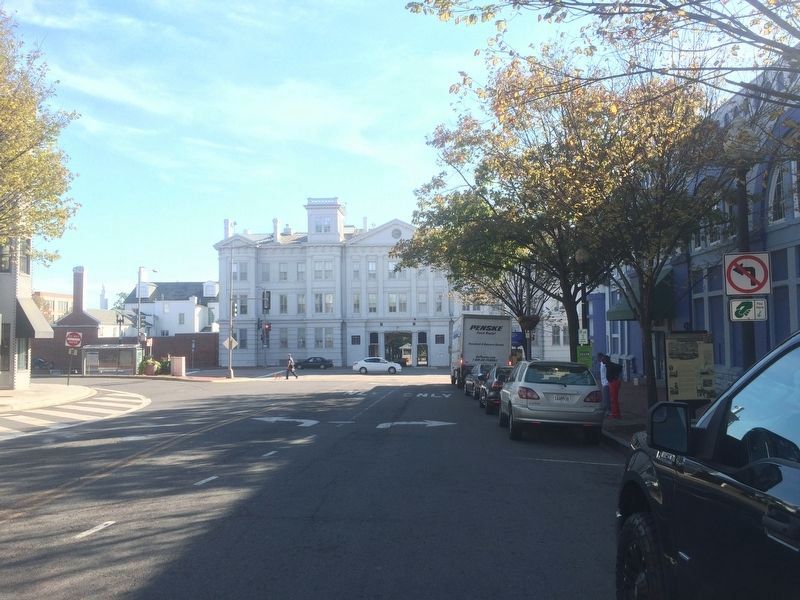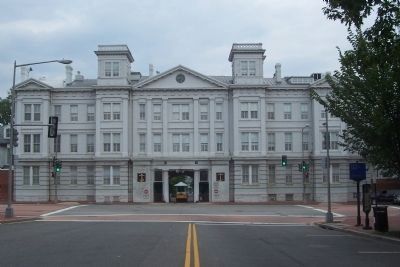Navy Yard in Southeast Washington in Washington, District of Columbia — The American Northeast (Mid-Atlantic)
Washington Navy Yard: Serving the Fleet
Tour of Duty
— Barracks Row Heritage Trail —
In front of you is the main gate of the Washington Navy Yard, established in 1799. It is the U.S. Navy's oldest shore facility in continuous use. Over time, workers here have built and repaired ships and their fittings, designed and developed ordnance (weapons and ammunition), and provided administrative support for the fleet.
Although city designer Pierre L'Enfant planned a commercial center for the site, its access to water and nearby timber made it a natural for ship building. The original gate, now topped by an 1878 addition, was designed in 1805 by architect Benjamin Henry Latrobe, the second architect of the U.S. Capitol.
The Navy Yard was nearly destroyed during the War of 1812. As British troops advanced on the city, the yard's commandant, Captain Thomas Tingey, ordered workers to set fire to buildings to keep them from the enemy. They spared only the Commandant's House, officers' quarters and the main gate. The Navy Yard was quickly rebuilt after the British withdrew.
The 22 vessels built here from 1806 until 18-1854 ranged from small 70-foot gunboats to the 246-foot steam frigate Minnesota. During this period, workers also repaired hundreds of ships and manufactured equipment, including anchors and chain cables. Engineers experimented with steam-powered warships.
The Navy Yard was the city's first reliable large employer. Unlike most southern enterprises, it offered well-paying skilled and unskilled jobs to both free Blacks and hired-out slaves. In addition, for more than a century, the Navy Yard was Washington's ceremonial gateway, welcoming important visitors to the nation's capital. (With thanks for research by Edward J. Marolda, Senior Historian, Naval Historical Center.)
Erected 2004 by Cultural Tourism DC. (Marker Number 9.)
Topics and series. This historical marker is listed in these topic lists: African Americans • Industry & Commerce • War of 1812 • Waterways & Vessels. In addition, it is included in the Barracks Row Heritage Trail series list. A significant historical year for this entry is 1799.
Location. 38° 52.616′ N, 76° 59.705′ W. Marker is in Southeast Washington in Washington, District of Columbia. It is in Navy Yard. Marker is on 8th Street Southeast north of M Street Southeast, on the right when traveling south. Touch for map. Marker is at or near this postal address: 770 M St SE, Washington DC 20003, United States of America. Touch for directions.
Other nearby markers. At least 8 other markers are within walking distance of this marker. Washington Navy Yard: Maker of Weapons (a few steps from this marker); Serving as the City's Diplomatic Gateway (about 300 feet away, measured in a direct line); William Prout: Community Builder
(about 300 feet away); Receiving Honored Servicemembers and Dignitaries (about 300 feet away); Latrobe Gate - Tingey House (about 400 feet away); The Washington Navy Yard (about 400 feet away); Teaching Sailors for the Fleet (about 400 feet away); Leutze Park Gun Collection (about 500 feet away). Touch for a list and map of all markers in Southeast Washington.
More about this marker. Photo captions:
Shad fishermen on the Anacostia in 1861, with the ships and docks of the Navy Yard in the background.
Captain Thomas Tingey, the Navy Yard's first commandant, served for 30 days. His house, built in 1804, still stands inside the Navy Yard.
Rear Admiral David Taylor, a pioneer of ship design, created the Experimental Model Basin in 1898 to test models of innovative ship hulls.
Michael Shiner worked as both a slave and a freeman in the Navy Yard for 52 years. When he wrote this description of the British Army's advance on Washington, spelling was not yet standardize. Today his words would read: "...as soon as we got sight of the British army raising that hill,
they looked like red flames of fire - all red coats and the stocks of their guns painted vermillion - and iron work shimmered like a Spanish dollar."
Between 1911 and 1917, the Navy Yard's experiments in its wind tunnel and with catapults helped develop the Navy's capacity to launch airplanes from warships.
In 1927, thousands of Washingtonians mobbed the Navy Yard, the city's ceremonial gateway, to welcome Charles Lindbergh home from his pioneering solo transatlantic flight.
Credits. This page was last revised on January 30, 2023. It was originally submitted on August 27, 2008, by Richard E. Miller of Oxon Hill, Maryland. This page has been viewed 2,316 times since then and 14 times this year. Last updated on March 7, 2019, by Devry Becker Jones of Washington, District of Columbia. Photos: 1. submitted on August 27, 2008, by Richard E. Miller of Oxon Hill, Maryland. 2, 3. submitted on October 30, 2016, by J. Makali Bruton of Accra, Ghana. 4. submitted on August 29, 2008, by Richard E. Miller of Oxon Hill, Maryland. • Bill Pfingsten was the editor who published this page.



